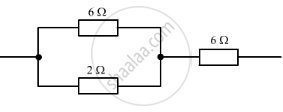Advertisements
Advertisements
Question
Five resistors, each 3 Ω, are connected as shown in Fig. Calculate the resistance
- between the points P and Q.
- between the points X and Y.

Solution

r1 and r2 are in series
∴ R1 = r1 + r2
= 3 + 3
= 6 Ω
Now R1 and r3 are in parallel
∴ `1/"R"_"p" = 1/"R"_1 + 1/"R"_3`
= `1/6 + 1/3`
= `(1 + 2)/6`
= `1/2`
- Resistance between P and Q = Rp = 2 Ω
- Resistance between X and Y r4, Rp and r5 are in series
∴ R = r4 + Rp + r5
R = 3 + 2 + 3
= 8 Ω
APPEARS IN
RELATED QUESTIONS
Differentiate between resistances in series and parallel.
State the law of combination of resistances in parallel.
An electric heater which is connected to a 220 V supply line has two resistance coils A and B of 24 Ω resistance each. These coils can be used separately (one at a time), in series or in parallel. Calculate the current drawn when:
(a) only one coil A is used.
(b) coils A and B are used in series.
(c) coils A and B are uses in parallel.
The figure given below shows three resistors?

Their combined resistance is:
(a) `1 5/7`Ω
(b) `14` Ω
(c) `6 2/3` Ω
(d) `7 1/2` Ω
Which of the following combinations have the same equivalent resistance between X and Y?
A battery of e.m.f. 15 V and internal resistance 2 `Omega` is connected to tvvo resistors of 4 ohm and 6 ohm joined.
(i) In series,
(ii) In para 1 lel. Find in each case the electrica I energy spent per minute in 6 ohm resistor.
Two resistors of resistance 4 Ω and 6 Ω are connected in parallel to a cell to draw 0.5 A current from the cell.
Calculate current in each resistor.
A particular resistance wire has a resistance of 3 ohm per meter. Find the potential difference of the battery which gives a current of 2 A in each of the 1.5 m length when connected in the parallel to the battery (assume that resistance of the battery is negligible).
An electrical appliance has a rating 100 W, 120V. The resistance of element of appliance when in use:
You are given four ammeters A, B, C and D having the least counts mentioned below:
(I) Ammeter A with least count 0.25 A
(II) Ammeter B with least count 0.5 A
(III) Ammeter C with least count 0.05 A
(IV) Ammeter D with least count 0.1 A
Which of the ammeters would you prefer for doing an experiment to determine the equivalent resistance of two resistances most accurately, when connected in parallel?
